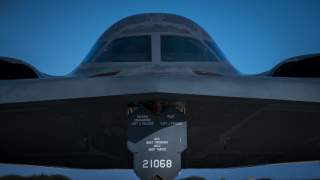U.S. Air Force B-2 Stealth Bomber to Get New Nuclear Weapon This Year
And so much more...
New weapons and technologies arming the Air Force’s stealthy B-2 bombers are expected to bring “massive firepower to even the most heavily-defended targets,” according to an official service acquisition report.
Specific adjustments, as outlined by the report, include the expected delivery of a new “earth-penetrating” upgraded B-61 mod 12 nuclear bomb for the aircraft - to arrive as soon as this year. Secondly, the stealth bomber is now being integrated with a new suite of on-board technologies to include improved sensors, avionics, intelligence and targeting, according to the Air Force 2018 Annual Acquisition Report.
The new avionics and targeting suite, called the Defense Management System (DMS), brings the aircraft an entirely new generation of technologies enabling the aircraft to elude enemy attacks and air-defense.
The DMS detects signals or “signatures” emitting from ground-based anti-aircraft weapons, Air Force officials have said. Current improvements to the technology are described by Air Force developers as “the most extensive modification effort that the B-2 has attempted.”
The first eight modified B-2s are slated to arrive in June, 2022, the service report states.
The modernized system, called a B-2 “DMS-M” unit, consists of a replacement of legacy DMS subsystems so that the aircraft can be effective against the newest and most lethal enemy air defenses.
Upgrades consist of improved antennas with advanced digital electronic support measures, or ESMs along with software components designed to integrate new technologies with existing B-2 avionics, according to an Operational Test & Evaluation report from the Office of the Secretary of Defense. The Air Force acquisition report aligns closely with these assessments, stating that the DMS “upgrades the threat warning systems on board by replacing aging antennas, electronics, display system and an autorouter.”
The autorouter introduces what could easily be referred to as a transformative technology for several key reasons; the report describes the autoloader as something which “which automates the re-planning of aircraft missions in flight.” This brings several key implications…. Increased automation lessens what’s often referred to as the “cognitive burden” for pilots. This frees up pilots to focus on pressing combat variables because computer automation is performing certain key procedural functions. Secondly, by allowing for “re-planning of aircraft missions in flight,” the autorouter brings a sizeable intelligence advantage. Instead of relying upon pre-determined target information, on-board intelligence can help pilots adjust attack missions as targets change and/or relocate.. while in flight. Much of these improvements can be attributed to an ongoing effort to implement a new computer processor into the B-2, a system reported by Air Force developers to be 1,000 times faster than the existing system.
Also, given the pace of emerging electronic warfare threats, it is indeed quite significant that the new DMS technical adjustments will increase the aircraft’s ability to “avoid electronic threats.”
Overall, it would not be an exaggeration to describe this technological upgrade as transformative, something that will propel the B-2's ability to attack in high-threat environments for decades. This is extremely important for several reasons. The B-2 is expected to remain operational for many years as the new B-21 bombers progressively arrive. Secondly, these kinds of upgrades will give the B-2 a much greater ability to fight against and/or elude the most modern air defenses. Much is being made of new, long-range, networked Russian-built air defenses reportedly able to operate on a larger scope of frequencies, leverage digital networking and draw upon improved computer processing speeds -- supposedly bringing the technology sufficient to hold even stealth bombers at risk.
Now it is not yet proven, of course, that these systems could actually “hit” a stealth aircraft, they definitely change the threat calculus. For instance, even if a stealth aircraft is detected in some way, that does not mean advanced air defenses can complete the “kill chain” and succeed in destroying the aircraft. Actually “hitting” a stealth bomber, according to retired Lt. Gen. David Deptula, Dean of the Mitchell Institute for Aerospace Studies, requires more narrow, high-frequency radar and the ability to move from a “detection” radar stage to the fire-control needed to hit the aircraft.
Air Force B-2 to Get New Nuclear Weapon This Year.
The Air Force report says the B-2 will be armed with a new B61-12 nuclear weapon by as soon as August of this year.
The B61-12 adds substantial new levels of precision targeting and consolidates several different kinds of attack options into a single weapon. Instead of needing separate variants of the weapon for different functions, the B61-12 by itself allows for earth-penetrating attacks, low-yield strikes, high-yield attacks, above surface detonation and bunker-buster options. Air Force officials described the B61-12 as having an “All Up Round.”
The latest version of the B61 thermonuclear gravity bomb, which has origins as far back as the 1960s, is engineered as a low-to-medium yield strategic and tactical nuclear weapon, according to nuclearweaponsarchive.org, which also states the weapon has a “two-stage” radiation implosion design.
The joint program completed developmental testing on June 20, 2018, and successfully conducted all 31 developmental flight test events. The B61-12 transitioned from the engineering and manufacturing development phase to the production phase October 26, 2018.
The evidence that the B61-12 can penetrate below the surface has significant implications for the types of targets that can be held at risk with the bomb.
By bringing an “earth-penetrating” component, the B61-12 vastly increases the target scope or envelope of attack. It can enable more narrowly targeted or pinpointed strikes at high-value targets underground - without causing anywhere near the same level of devastation above ground or across a wider area.
Osborn previously served at the Pentagon as a Highly Qualified Expert with the Office of the Assistant Secretary of the Army - Acquisition, Logistics & Technology. Osborn has also worked as an anchor and on-air military specialist at national TV networks. He has a Masters in Comparative Literature from Columbia University.
This first appeared in Warrior Maven here.

